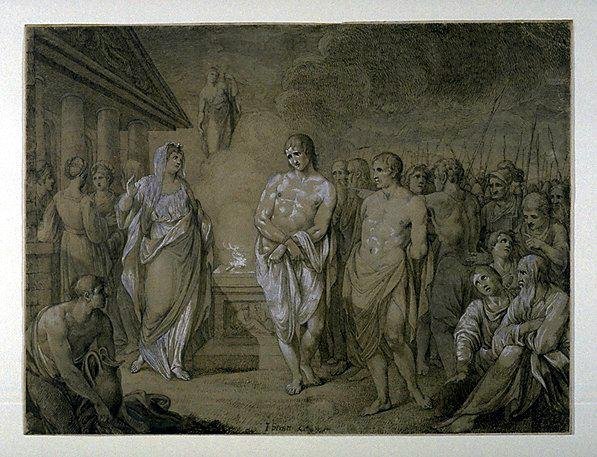- Iphigeneia in Tauris
Infobox_Play | name = Iphigeneia in Tauris

caption = Orestes and Pylades brought before Iphigenia by Joseph Strutt
writer =Euripides
chorus = Greek Slave Women
characters =Iphigeneia
OrestesPylades
KingThoas Athena
herdsman
servant
setting = Tauris, a region ofScythia in the northernBlack Sea "Iphigeneia in Tauris" ( _el. Ιφιγένεια εν Ταύροις, "Iphigeneia en Taurois") is a drama by the playwright
Euripides , written sometime between414 BC and412 BC . It has much in common with another of Euripides's plays, "Helen", and is often described as a romance, amelodrama or an escape play.Fact|date=May 2008Background
Years before the time period covered by the play, the young
princess Iphigeneia narrowly avoided death bysacrifice at the hands of her father,Agamemnon . (See plot of "Iphigeneia at Aulis ".) At the last moment, however thegoddess Artemis , to whom the sacrifice was to be made, intervened and replaced Iphigeneia on the altar with a deer, saving the girl and sweeping her off to Tauris. She has since been made a priestess at the temple of Artemis in Tauris, a position in which she has the gruesome task ofritual ly sacrificing foreigners who land on King Thoas's shores.Iphigeneia hates her forced religious servitude and is desperate to contact her family in
Greece , inform them that, thanks to the miraculous swap performed by Artemis, she is still alive and return to her homeland, leaving the role of high priestess to someone else. Furthermore, she has had a prophetic dream about her younger brother Orestes and believes, based on it, that he is dead.Meanwhile, Orestes has killed his mother
Clytemnestra to avenge his fatherAgamemnon with assistance from his friendPylades . He becomes haunted by theErinyes for committing the crime and goes through periodic fits of madness. He is told byApollo to go toAthens to be brought to trial (as portrayed in "Eumenides" byAeschylus ). Although the trial ends in his favour, the Erinyes continue to haunt him. Apollo sends him to steal a sacred statue of Artemis to bring back to Athens so that he may be set free.Plot
Contrary to Iphigeneia's dream, then, Orestes is still alive and on his way to Tauris with Pylades to steal the sacred statue. They have no idea that Iphigeneia is there. They are captured by Taurian guards and brought to the temple to be killed, as is customary.
Iphigeneia and Orestes discover one another's identities and together devise a plan to escape. Iphigeneia tells King Thoas that the statue of Artemis has been spiritually polluted because of her brother's
matricide and advises him to make the foreigners cleanse the idol in the sea to remove the dishonour she, as its keeper, has brought upon it. The three Greeks use this as an opportunity to escape on Orestes and Pylades's ship, bringing the statue with them. Thoas vows to pursue and kill them but is stopped by the goddessAthena , who appears at the end to give instructions to the characters.Translations
* Robert Potter, 1781 — verse: [http://etext.library.adelaide.edu.au/e/euripides/ip_tauri/ full text]
*Edward P. Coleridge , 1891 — prose
*Gilbert Murray , 1910 — verse: [http://onlinebooks.library.upenn.edu/webbin/gutbook/lookup?num=5063 full text]
*Arthur S. Way , 1912 — verse
*Augustus T. Murray , 1931 — prose
*Witter Bynner , 1956 — verse
*Moses Hadas andJohn McLean , 1960
*David Kovacs , 1999 - prose
*J. Davie , 2002
*J. Morwood , 2002
Wikimedia Foundation. 2010.
